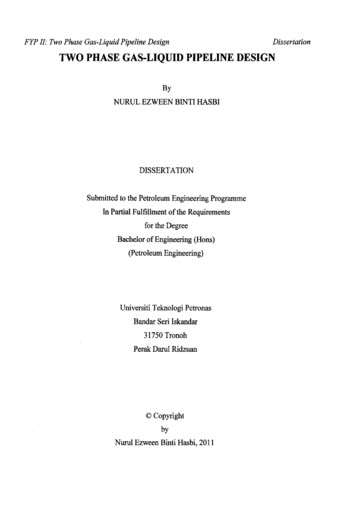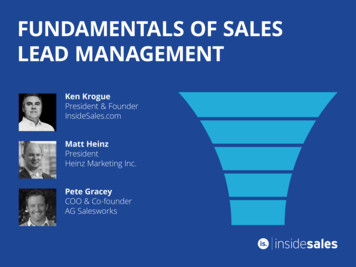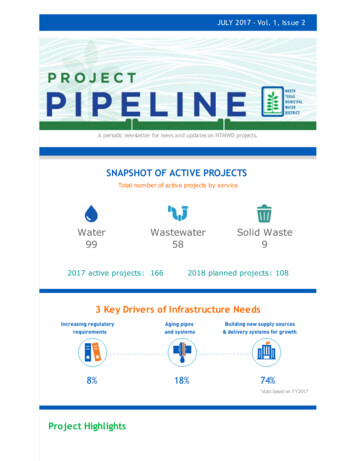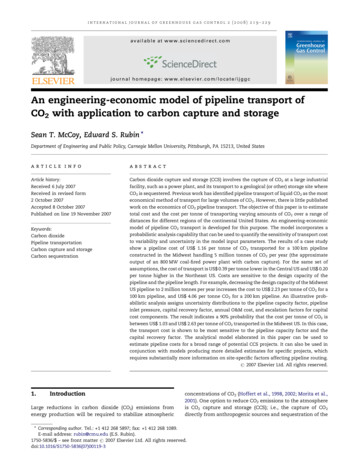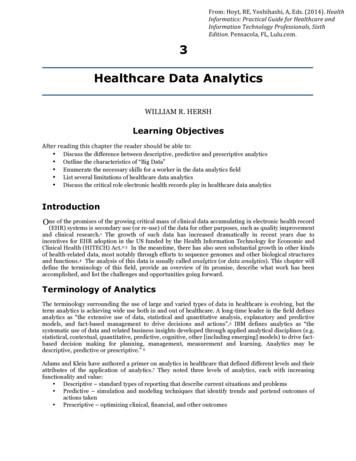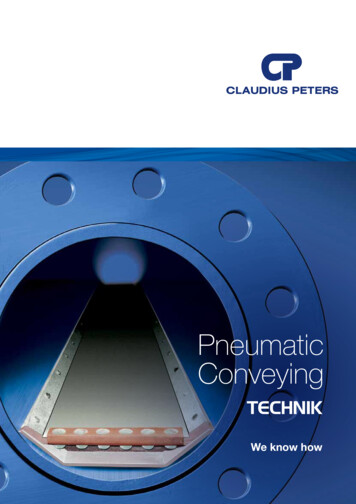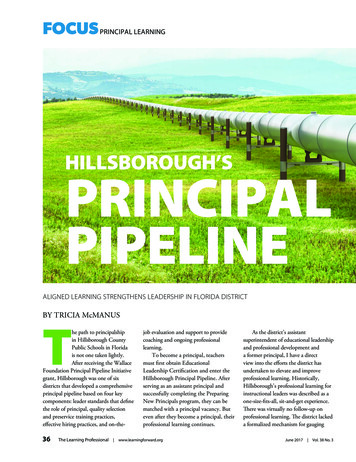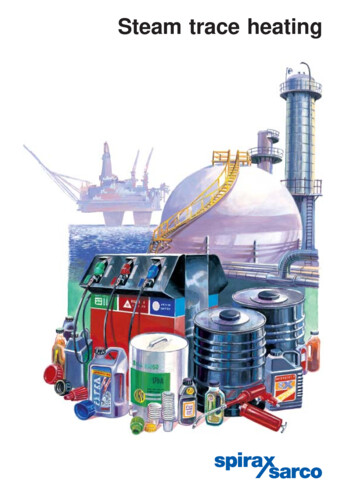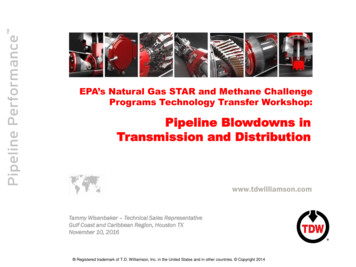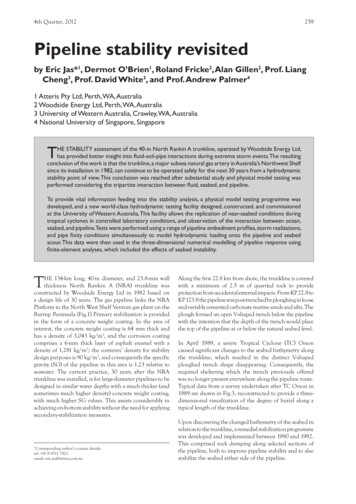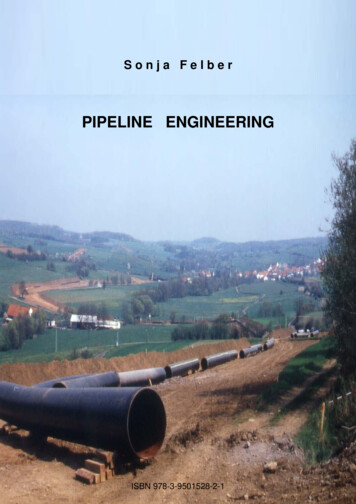
Transcription
Sonja FelberPIPELINE ENGINEERINGISBN 978-3-9501528-2-1
Sonja FelberPIPELINE ENGINEERING
Ao.Univ.Prof. Dipl.-Ing. Dr.techn. Sonja FelberVienna University of TechnologyInstitute for Building Construction and Technology (E 206)Karlsplatz 13A-1040 Vienna, AustriaPIPELINE ENGINEERINGFirst Edition 2009ISBN 978-3-9501528-2-1Editor and Distribution:Oesterreichische Gesellschaft fuer Schweisstechnik (OEGS)Arsenal Objekt 207A-1030 Wien1 - (2009) ISBN 978-3-9501528-2-1This work is protected under copyright.Single photocopies of single subchapters may be made for personal use as allowed by national copyrightlaws. Permission of the Publisher and payment of a fee is required for all other photocopying, includingmultiple or systematic copying, copying for advertising or promotional purpose, resale, and all forms of document delivery. Special rates are available for educational institutions that wish to make photocopies fornon-profit educational classroom use. Permission may be sought directly from OEGS. In the USA, usersmay clear permission and make payments through the Copyright Clearance Centre. Other countries mayhave a local rights agency for payments.Tables of contents may be reproduced for internal circulation, but permission of OEGS is required for external resale or distribution of such material. Permission of the Publisher is required for all other derivativeworks, including compilations and translations. Permission of the Publisher is required to store or useelectronically any material contained in this work, including any chapter or part of a chapter. Except asoutlined above, no part of this work may be reproduced, stored in a retrieval system or transmitted in anyform or by any means, electronic, mechanical, photocopying, recording or otherwise, without prior writtenpermission of the Publisher. Address permission requests to OEGS.No responsibility is assumed by the Publisher and Author for any injury and/or damage to persons or property as a matter of products liability, negligence or otherwise, or from any use or operation of any methods, products, instructions or ideas contained in the work, because of rapid advances in science.Copyright OEGS 2009. All rights reserved.Printed in AustriaCover: Concept & design, Sonja Felber
PIPELINE ENGINEERINGKEYWORDSPipeline engineering, ferritic-pearlitic and bainitic steels (pipeline-steels), duplexsteels, pipeline failures, natural gas pipelines, crack-arrestors, pipeline corrosion, corrosion protection of pipelines, pipelines in Austria, in Europe, world wide, pipelinewelding, heat treatment of pipelines, fracture mechanical investigations, CTOD tests,crack-arrest tests, tensile tests, impact tests, hardness tests, heat-input, alloying elements of thermomechanically treated steels and duplex-steels, metallography, fractography, pipeline design, operation of pipelines, radiographic testing, ultrasonic testing, visual testing, quality management in pipeline engineering, pigging, analysis offailures in pipeline engineering.SCHLAGWOERTERPipelinebau, ferritisch-perlitische und bainitische Staehle (Pipeline-Staehle), DuplexStaehle, Schadenfaelle an Pipelines, Erdgasleitungen, Rissarrestoren, Korrosion anPipelines, Korrosionsschutz von Pipelines, Pipelines in Oesterreich, in Europa, weltweit, Schweissen von Pipelines, Waermebehandlungen an Pipelines, bruchmechanische Untersuchungen, CTOD-Untersuchungen, Rissauffang-Untersuchungen, Zugversuche, Kerbschlagbiegeversuche, Haertepruefungen, Streckenenergie, Legierungselemente von thermomechanisch behandelten Staehlen und Duplex-Staehlen,Metallographie, Fraktographie, Projektierung von Pipelines, Betrieb von Pipelines,radiographische Untersuchungen, Ultraschallpruefung, visuelle Kontrolle, Qualitaetsmanagement im Pipelinebau, Molchungen, Fehlerauswertungen beim Bau von Pipelines.Sonja Felber0.1
PIPELINE ENGINEERINGABSTRACTPipelines offer an economically and ecologically reliable, good solution for the transport of liquids and gases worldwide. Even in a small country like Austria they are analmost indispensable means of transport, especially for natural gas.THEORETICAL PART:This work addresses the most important questions industrial engineers and scientistsare confronted with, when working in the fields of project planning, construction, andoperation of pipelines.Starting from a description of the situation in Austria and a comparison with worldwide solutions, the following fields are examined: Damage caused by cracks and corrosion, as well as countermeasures; materials used in pipeline construction (ferriticpearlitic, bainitic, and duplex-steels) and their processing properties (especially concerning welding technology); aspects of materials testing and quality management.EXPERIMENTAL PART:Based on numerous welding-technological and fracture-mechanical examinations,the influencing parameters and limits, essential for a problem-free construction andreliable operation of pipelines, are discussed and limits established.MATHEMATICAL PART:This part offers mathematical approaches for the predetermination of welding-technological and fracture-mechanical parameters, to be considered during the construction and the subsequent testing of pipelines.0.2Sonja Felber
PIPELINE ENGINEERINGKURZREFERATRohrleitungen stellen weltweit eine oekonomisch und oekologisch zuverlaessige undgute Loesung zum Transport fluessiger und gasfoermiger Stoffe dar. Auch in einemkleinen Land wie Oesterreich sind sie kaum zu ersetzende Transportmittel, vor allemfuer Erdgas.THEORETISCHER TEIL:Diese Arbeit ist eine Zusammenstellung der wichtigsten Details, mit denen Ingenieure im industriellen Einsatz und Wissenschafter konfrontiert werden, wenn sie im Bereich Projektierung, Bau und Betrieb von Rohrleitungen arbeiten.Ausgehend von einer Beschreibung der Situation in Oesterreich und einer Gegenueberstellung zu weltweiten Loesungen, sollen die Bereiche: Schadensfaelle durchRisse und Korrosion und Gegenmassnahmen, verwendete Werkstoffe (ferritisch-perlitische, bainitische und Duplex-Staehle) und ihre Verarbeitungseigenschaften (besonders schweisstechnische), prueftechnische Aspekte und Qualitaetssicherung behandelt werden.EXPERIMENTELLER TEIL:Anhand von zahlreichen schweisstechnischen und bruchmechanischen Untersuchungen werden die Einflussgroessen fuer eine problemlose Fertigung und einenzuverlaessigen Betrieb von Pipelines bestimmt und ihre Grenzen festgelegt.RECHNERISCHER TEIL:Weiters werden rechnerische Ansaetze fuer die Vorherbestimmung der schweisstechnischen und bruchmechanischen Parameter, die sich bei der Fertigung undeiner anschliessenden Pruefung ergeben, geliefert.Sonja Felber0.3
PIPELINE ENGINEERINGPREFACEThe first German edition of this book has been written as a habilitation at ViennaUniversity of Technology. The author is thankfull for suggestions to this book.The individual introductions to the various subjects are intended also to open thisbook to interested experts with different knowledge and background, and not justonly to scientifically qualified readers.Hopefully the variaty of information by the dissemination of this book will be suppliedto an interested and attentive circle of readers, to lead to a better understanding ofthe problems possibly occurring with ferritic-pearlitic steels, bainitic steels, or duplexsteels, especially with regard to the properties of the used materials, their processsing (especially welding technology), the following testing (e.g. destructive and nondestructive testing, fracture mechanical, metallographical, and fractographical methods), the quality management, the ecology, and the economy.Ao.Univ.Prof. Dipl.-Ing. Dr.techn. Sonja Felber0.4Sonja Felber
PIPELINE ENGINEERING0 CONTENTpage1Introduction1.11.1Development and Use of Pipeline-Steels1.51.1.1Development of Pipeline-Steels1.51.1.2Use of Pipeline-Steels1.111.1.2.1Natural Gas and Oil Pipelines in Austria1.121.1.2.2Natural Gas and Oil Pipelines in Europe1.191.1.2.3Natural Gas and Oil Pipelines in America1.261.1.2.4Natural Gas and Oil Pipelines in Australia and New Zealand1.311.1.2.5Natural Gas and Oil Pipelines Worldwide1.331.2Development and Use of Duplex-Steels1.361.2.1Development of Duplex-Steels1.361.2.2Use of Duplex-Steels1.381.3Failures, Causes, and Avoidance1.401.3.1Failures of Pipelines1.401.3.2Crack-Arrestors for Pipelines1.53Crack-Arrestors Causing the Crack to Run Into a PipeSection of Reduced Hoop StressCrack-Arrestors Using Application of a Pre-StressedBandage to Certain Sections of the PipelineCrack-Arrestors Using Inserting Pipe Sections with HighFracture ToughnessCrack-Arrestors Causing the Crack to Run Into a Row ofSlotsCrack-Arrestors Preventing the Flap OpeningCrack-Arrestors Preventing the Flap Opening by Means ofLarge Masses Along the Pipe Length, Which Must n of Pipelines1.591.3.4Corrosion Protection Against External Corrosion1.601.3.4.1Coating of Pipes1.60Temporary CoatingPlant-Applied CoatingSonja Felber1.611.620.5
PIPELINE ENGINEERINGCoating in the FieldCoatings for Extreme Service Requirements1.641.651.3.4.2Cathodic Corrosion Protection (CCS)1.671.3.5Corrosion Protection Against Internal Corrosion1.711.3.6Standards, Rules, and Regulations1.751.3.7Determination and Evaluation of a Defect Analysis1.842Materials for Pipelines2.12.1Pipeline-Steels2.32.1.1Chemical Composition2.32.1.1.1Standards and Designations2.32.1.1.2Alloying Elements2.92.1.1.3Effect of Alloying rVanadium, Niobium, pper, Nickel, sical Properties2.272.1.2.1Phase Diagrams, Transformation Behavior2.272.1.2.2Precipitation Behavior2.34Carbides, NitridesV-Nitride(Si, Corrosion Behavior2.372.372.372.382.382.382.38Sonja Felber
PIPELINE ENGINEERING2.1.3Mechanical 522.1.4.2Forming2.54Thermomechanical Rolling2.1.4.3Pipe ManufactureProduction of Longitudinal Welded Pipes (U-O-Process)Production of Spiral Welded Pipes2.552.662.682.702.1.5Manufacturing Properties2.722.1.6Standards and Technical Terms of Delivery2.722.1.7Tested Pipeline-Steels2.802.1.7.1Pipeline-Steel X702.80Longitudinal Welded Pipes Made of X70Spiral Welded Pipes Made of X702.822.822.1.7.2Pipeline-Steel X802.832.1.7.3Joined Spiral Pipes Made of X70 and X802.872.1.7.4Comparison of Pipeline-Steels X70 and X802.872.1.7.5Pipeline-Steel X1002.892.1.7.6Pipeline-Steel X1202.902.2Duplex-Steels2.912.2.1Chemical Composition2.912.2.1.1Standards and Designations2.912.2.1.2Alloying Elements2.982.2.1.3Effect of Alloying urNitrogenChromiumCopperMolybdenumNickelSonja 62.1170.7
PIPELINE ENGINEERINGTungsten2.1192.2.2Physical Properties2.1192.2.2.1Phase Diagrams, Transformation Behavior2.1202.2.2.2Precipitation Behavior2.124α (Alpha )- or δ (Delta )- and G-Phaseγ2-Phaseσ(Sigma)-Phaseχ(Chi)- and η(Eta)-Phaseχ(Chi)-Phaseη(Eta)-, R- or .1362.1382.1392.1392.1402.2.2.3Corrosion Behavior2.1422.2.3Mechanical 2.1492.2.4.2Forming2.1502.2.4.3Pipe Manufacture2.1542.2.5Manufacturing Properties2.1552.2.6Standards and Technical Terms of Delivery2.1552.2.7Tested Duplex-Steels2.1572.2.7.1Duplex-Steel 1.4462 (Rolled)2.1582.2.7.2Duplex-Steel 1.4462 (Forged)2.1592.3Comparison of Pipeline-Steels and Duplex-Steels2.1603Weldability and Heat Treatment3.13.1Weldability and Heat Treatment of Pipelines Made of PipelineSteels3.3WeldabilityHeat Treatment3.1.1Welding AbilityCarbon Equivalent (Ceq) and Hardness0.83.33.33.43.4Sonja Felber
PIPELINE ENGINEERINGHydrogen Induced Cracking and HardnessAlloying Elements in the Weld Metal3.93.153.1.2Welding Possibility3.153.1.2.1Manual Metal Arc Welding (MMAW, 111) of CircumferentialWelds3.16Welding in Vertical Down Position With Cellulosic Electrodes (111-C-PG)Welding in Vertical Down Position With Basic Electrodes(111-B-PG)Combined Welding With Cellulosic and Basic ElectrodesWelding in Vertical Up Position With Cellulosic Electrodes(111-C-PF)Welding in Vertical Up Position With Basic Electrodes(111-B-PF)Comparison of the Manual Metal Arc Welding Processes3.1.2.2Gas Metal Arc Welding of Circumferential WeldsFully Mechanized Gas Metal Arc Welding Using SolidWire (135)MAG-Welding With Solid Wire in Vertical Down PositionMAG Orbital Welding in Vertical Down Position UsingRoot Pass ProtectionMAG Orbital Welding in Vertical Down Position WithoutRoot Pass ProtectionThe CRC-Evans-ProcessThe CAPS-ProcessFully Mechanized Gas Metal Arc Welding in Vertical UpPosition Using Filler Wire (136)3.1.2.3Tungsten Inert Gas (TIG) Welding of Circumferential Welds(141)TIG Cold Wire TechnologyTIG Hot Wire Technology3.1.2.4Submerged Arc Welding of Circumferential Welds 463.523.583.603.603.613.62Submerged Arc Welding of Pipes to Obtain Double Length 3.623.1.2.5General Comparison of the Common Welding Processes3.633.1.2.6Hyperbaric Welding3.753.1.2.7New Developments of Pipeline Welding Processes3.76Stir Friction Welding of Circumferential WeldsElectron Beam Welding of Circumferential WeldsReduced Pressure Electron Beam WeldingSonja Felber3.763.793.820.9
PIPELINE ENGINEERINGLaser Welding of Circumferential WeldsLaser Hybrid Welding of Circumferential Welds3.833.853.1.3Welding Safety3.893.1.4Standards, Rules, and Regulations3.913.1.5Heat Treatment3.1203.2Weldability and Heat Treatment of Pipelines Made of DuplexSteels3.1343.2.1Welding Ability3.134Chromium and Nickel Equivalent (Creq and Nieq)Coarse Grain Zone in the Heat Affected ZoneFerrite Content in the Weld Metal and in the Heat AffectedZoneHydrogen Induced CracksHot Cracks3.1373.1393.1413.1423.1433.2.2Welding Possibility3.1453.2.2.1Manual Metal Arc Welding of Circumferential Welds3.1453.2.2.2Gas Metal Arc Welding of Circumferential Welds3.148Tungsten Inert Gas WeldingGas Metal Arc Welding Using Solid WireMetal Inert Gas WeldingMetal Activ Gas WeldingFiller Wires3.1483.1533.1543.1553.1573.2.2.3Submerged Arc Welding of Circumferential Welds3.1603.2.2.4General Comparison of the Welding Processes3.1643.2.2.5New Developments of Pipeline Welding Processes3.1703.2.3Welding Safety3.1703.2.4Standards, Rules, and Regulations3.1723.2.5Heat Treatment3.1753.3Comparison of the Weldability and Heat Treatment Proceduresfor the Construction of Pipelines3.1824Welding and Mechanical Technological Tests4.1Welding Technological TestsTensile TestsHardness TestingImpact Testing0.104.34.54.64.7Sonja Felber
PIPELINE ENGINEERINGStandards, Rules, and Regulations4.114.1Welding Technological and Mechanical TechnologicalTesting of Pipeline-Steels4.234.1.1Welding Technological and Mechanical TechnologicalTesting of the Pipeline-Steel X704.23Testing of Longitudinal Welded Pipes Made of X70Testing of Spiral Welded Pipes Made of X704.234.314.1.2Welding Technological and Mechanical TechnologicalTesting of the Pipeline-Steel X804.334.1.3Welding Technological and Mechanical TechnologicalTesting of the Pipeline-Steel X1004.354.1.4Welding Technological and Mechanical TechnologicalTesting of the Pipeline-Steel X1204.364.1.5Summary of the Welding Technological and MechanicalTechnological Tests of the Pipeline-Steels andComparison With the Values of References4.364.2Welding Technological and Mechanical TechnologicalTesting of Duplex-Steels4.384.2.1Welding Technological and Mechanical TechnologicalTesting of the Duplex-Steel 1.4462 (Rolled)4.384.2.2Welding Technological and Mechanical TechnologicalTesting of the Duplex-Steel 1.4462 (Forged)4.39Plate Made of 1.4462 Forged (Manual Metal Arc Welding)Plate Made of 1.4462 Forged (Submerged Arc Welding)Pipe Made of 1.4462 Forged4.414.424.424.2.3Summary of the Welding Technological and MechanicalTechnological Tests of Duplex-Steels and Comparison WithValues of References4.434.3Summary of the Results and Comparison With References4.444.3.1Results of the Tests of Pipeline-Steels4.444.3.2Results of the Tests of Duplex-Steels4.454.3.3Comparison of the Results of the Tests4.465Fracture Mechanical Testing5.1IntroductionCTOD-TestsCrack-Arrest TestingSonja Felber5.35.95.110.11
PIPELINE ENGINEERINGManufacturing of the SpecimensPerforming of the TestsEvaluation of the CTOD-TestsEvaluation of the Crack-Arrest TestsStandards, Rules, and Regulations5.125.205.265.295.305.1Results of the Fracture Mechanical Tests on Pipeline-Steels5.335.1.1Fracture Mechanical Testing of the Pipeline-Steel X705.335.1.1.1CTOD-Tests on the Pipeline-Steel X705.335.1.1.2Crack-Arrest Tests on the Pipeline-Steel est-SpecimensFull-Thickness Compact-Crack-Arrest-SpecimensBase Material - Different Types of SpecimensWeld Metal - Different Types of SpecimensHeat Affected Zone - Different Types of SpecimensTemperature Range for ure Mechanical Tests on the Pipeline-Steel X805.1.3Summary of the Fracture Mechanical Results of Pipeline-Steels 5.41and Comparison With Values in References5.2Results of the Fracture Mechanical Tests on Duplex-Steels5.455.2.1Fracture Mechanical Tests on the Duplex-Steel 1.4462(Rolled)5.455.2.1.1CTOD-Tests on the Duplex-Steel 1.4462 (Rolled)5.455.2.1.2Crack-Arrest Test on the Duplex-Steel 1.4462 (Rolled)5.465.2.2Fracture Mechanical Tests on the Duplex-Steel 1.4462 (Forged) 5.465.2.2.1CTOD-Tests on the Duplex-Steel 1.4462 (Forged)5.465.2.2.2Crack-Arrest Tests on the Duplex-Steel 1.4462 (Forged)5.475.2.3Summary of the Fracture Mechanical Results of Duplex-Steelsand Comparison With Values in References5.475.3Fracture Mechanical Safety and Fatigue Life Prediction5.485.3.1Description of the Defects5.485.3.2Determination of the Stresses5.505.3.3Determination of KIcomponent5.515.3.4Characteristic Data of the Material5.520.125.41Sonja Felber
PIPELINE ENGINEERING5.3.5Determination of the Critical Defect Size5.525.3.6Assessment5.535.3.7Failure Assessment Using the CTOD-Design-Curve5.535.3.8The R6-Method (Two-Criteria-Method, Failure xample: Fracture Mechanical Safety and Life-Time Estimations for a Natural Gas Pipeline Pipe Made of X705.63Fracture Mechanical Model6Material Physical ExaminationsIntroductionLight MicroscopeMicrohardness TestingQuantitative Micro Structural AnalysisScanning Electron Microscope (SEM)Electron Probe MicroanalysisTaking and Preparation of the SpecimensStandards, Rules, and Regulations6.1Material Physical Examinations of Pipeline-SteelsNitric Acid Etching FluidLight Microscopic ExaminationsMicrohardness TestingQuantitative Micro Structural AnalysisScanning Electron Microscopic ExaminationsElectron Probe Microanalysis6.2Material Physical Examinations of Duplex-SteelsEtching Fluid According to Lichtenegger and BloechEtching Fluid 8 According to the Handbook of the Metallographic Etching ProcessesLight Microscopic ExaminationsMicrohardness TestingQuantitative Micro Structural AnalysisScanning Electron Microscopic ExaminationsElectron Probe 6.366.416.3Summary of the Results and Comparison With References6.477Design, Construction, and Service of Pipelines7.17.1Onshore Pipelines7.3Sonja Felber0.13
PIPELINE l Engineering for the Building of a TrenchBuilding of the PipelineWelding and Hauling TechnologyField Experiences With X80Manual Metal Arc WeldingMechanized WeldingTesting of Welded JointsCoatingHauling of the PipelineCivil Engineering for the Hauling of a PipelineTesting of the Pipeline After Filling the TrenchCivil Engineering, Measuring, and 07.457.1.3Service7.467.1.4Quality Management7.587.1.5Standards, Rules, and Regulations7.617.1.6Economical Considerations7.1077.1.7Safety, Conservation, and Ecological Aspects7.1157.2Offshore 257.2.3Service7.1327.2.4Quality Management7.1347.2.5Standards, Rules, and Regulations7.1347.2.6Economical Considerations7.1347.2.7Safety, Conservation, and Ecological Aspects7.1368Quality Records8.18.1Quality Records in General8.3QUALITY-MANAGEMENT-RECORD FOR THE CONSTRUCTION OF THE PIPELINEEXPLANATIONS TO THE ABBREVATIONS AND TERMSUSEDCONTENTGENERAL DESCRIPTION OF THE NATURAL GAS PIPELINE0.148.58.78.88.9Sonja Felber
PIPELINE ENGINEERINGTECHNICAL DATAORGANISATIONAL DATA(COUNTRY 1) SIDEORGANISATIONWELDING TECHNOLOGYTESTING TECHNOLOGYCONSTRUCTION LOT 1 - INSPECTION OF THE WELDING WORKCONSTRUCTION LOT 2 - INSPECTION OF THE WELDING WORKCOMPARISON OF THE TWO CONSTRUCTION LOTSFURTHER INTERESTING 188.208.218.248.2Comparison of Different Pipeline Projects8.25RREFERENCES (Catalogue of References)R.1AAPPENDIX (Coloured Pictures, Diagrams, and Maps)A.1SSUPPLEMENTS (Tables, Diagrams, and Maps)S.1IINDEX (Acknowledgements, Abbreviations, Units, Symbols inFormulas, and Designations of Specimens, and Index)I.1DDVD (Pipeline Engineering Book)D.1Sonja Felber0.15
graphy, pipeline design, operation of pipelines, radiographic testing, ultrasonic tes-ting, visual testing, quality management in pipeline engineering, pigging, analysis of failures in pipeline engineering. SCHLAGWOERTER Pipelinebau, ferritisch-perlitische und bainiti
